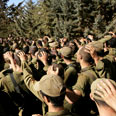
Seeing the big picture
Stunning images: Three photographers launch first-of-its kind photojournalism center in Israel
Three years after winning The Pulitzer Prize for news photography, Israeli photographer Oded Balilty is opening a center for documentary photography in Tel Aviv's Florentin neighborhood together with photographers Dan Balilty and Sebastian Scheiner.
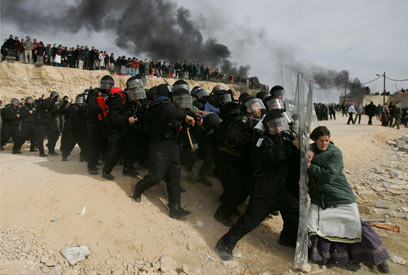
Settler resisting IDF troops. Februay 2006 (Photo: Oded Balilty)
DocuClub is in essence the first center in Israel to deal with photojournalism and will offer photographers space to present their work in an exhibition gallery as well as artist meetings and workshops.
"After years of taking pictures in Israel, all of a sudden the other shoe dropped – there is a crazy paradox here," said Oded Balilty. "Even though Israel produces endless news events in a year and, as a result, a huge quantity of photographs, at the end of the day, we don't have anywhere to present our work. We decided to open the center not only in order to sell pictures, but most of all in order to create a discourse on photojournalism, which is something very lacking here."
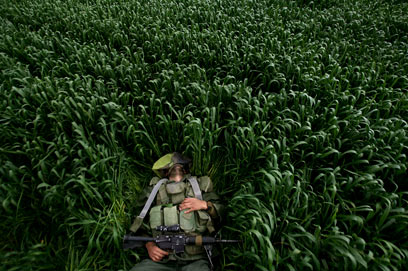
Soldier on the Gaza border (Photo: Uriel Sinai)
"Documentary photos are published in the press and on websites on a daily basis, but, beyond that, there are nearly no other platforms that provide exposure for this work. We thought if no one else did it for us, maybe the time has come for us to do it for others. We thought that the story of this place needs to be told beyond the pages of the newspaper."
Balilty admits that only after winning a Pulitzer – and a string of international prizes after it – did a Tel Aviv gallery decide to represent his work in Israel. For others, including his cousin and partner in the DocuClub initiative, photographer Dan Balilty, the path to major art galleries in Israel was still blocked.
Missing a home
Dan Balilty: "This is the home that we are missing, one that allows us to show our work, to be exposed to others' work, to share and hear the professionals' opinions. We made our own way professionally by trekking by foot through the field without a guiding hand. If a place like this had existed then, a lot of mistakes could have been avoided. It is training that was not provided us as young photographers."
What is documentary photography exactly?
Oded Balilty: "Non-staged photography that tells a story. The goal of documentary photography is to weave the history into the picture. For me, good documentary photography is photography in which the photographer cannot be felt. Our role is to tell the story without interrupting. Therefore, DocuClub will place an emphasis on the aesthetics of the photo while maintaining the ethics of documentary photography."
Do Israeli galleries reject documentary photography because they don't perceive the genre as artistic in the classical sense?
Oded Balilty: "Absolutely, yes. I think that here photojournalism is not treated as art, but as documentary, even though there are stories that photograph wonderfully from a visual perspective."
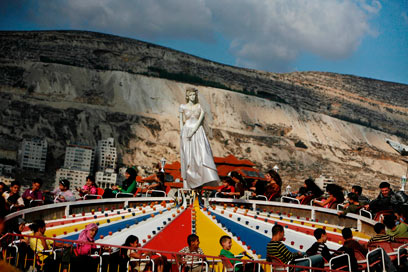
Amusement park project in West Bank (Photo: Tara Todras)
Dan Balilty: "There are photographers who have a different perspective on reality such that their photography is artistic in their interpretation of reality. I don't think that photojournalism is inferior. It is a genre that started the art of photography and will never be extinct. We will always have a need to document the reality around us."
Oded and Dan Balilty currently work together for the Associated Press, for whom their third partner in the DocuClub initiative, Sebastian Scheiner, also works.
The idea behind locating the gallery in the heart of Florentin is not by chance. "We found an amazing space here, and the atmosphere of the neighborhood also seemed fitting," said Dan Balilty. "There is an atmosphere of action here and it is full of young people. In addition, the only thing you need to do is step out of the gallery and start taking pictures. There are a lot of goings-on in this neighborhood. It is a very sexy area."
Connecting between stills and documentary
Among the issues on the new gallery's agenda is connecting between stills photographers and documentary film makers. "It's a connection that happens, but not enough," said Oded. "We want to turn up the volume.
According to Dan, this is a natural connection. "Every still-frame digital camera today gives you the option for video," he noted.
Dan added, "The idea of connecting between the fields doesn't make us revolutionary. It is happening throughout the world. It's been done before us, just not as much in Israel. It is another way of tell a story. At the end of the day, video and stills speak the same language, just with a different accent. Multi-media is the child born to stills and video."
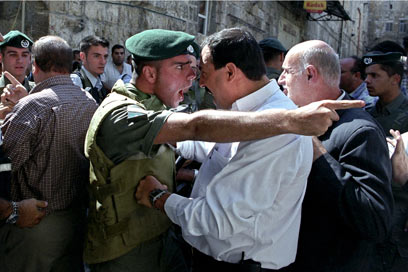
Ongoing conflict in Jerusalem (Photo: Amit Shabi)
The center will open on August 5 with an exhibit of photographs of the decade curated by Israel Prize recipient Alex Livak. Twenty-seven local and foreign photographers working in Israel and the West Bank will present their work in the exhibit, which will be open to the public until the end of September.
Among the prominent names featured in the exhibit alongside Livak, Oded and Dan Balilty and Sebastian Scheiner are Ziv Koren, head of Bezalel's photography department Miki Kretzman, Pavel Wolberg, Eldad Refaeli, New York Times photographer in Israel Rina Castelnuovo, as well as others from the Associated Press, AFP, and Getty Images.
Current identity of photography
According to Oded Balilty, the exhibition is photography's current identity. "The gamut of photographers represents the identity card of what has happened here – different photographic styles and different points of view. This is a first exhibition, after which we will present rotating thematic exhibits on various subjects every two months."
Their choice of Alex Livak as curator for the exhibit of the decade was a natural one for Dan and Oded Balilty. "At a young age, Alex's pictures already instilled in me a great desire to be a photographer," said Dan. "It was obvious that we would jump on the opportunity for him to curate an exhibit at our center."
Oded also was not short on superlatives for the veteran Israeli photographer. "Alex Livak is a dear friend. In 2008, he curated an exhibit in Jerusalem of my photographs from China. This was a chance to collaborate again," he said.
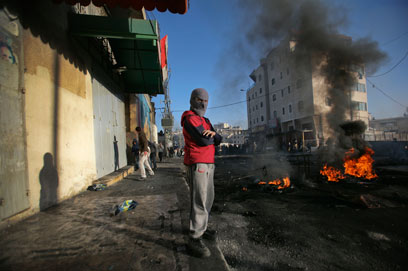
Riots in Shuafat refugee camp (Photo: Dan Balilty)
"Alex has a very unique point of view. Just like he is capable of walking through the street and seeing and showing us day-to-day things that we don't see, he also managed to compile from hundreds of photographs from those that we perhaps would have passed by without noticing. Curating was great work, and the choices, in my opinion, present something other than the trivial and respect the intelligence of the viewer, and mainly suggest outside-of-the-box thinking."
Israeli pride
A quick look at the list of Israeli photographers participating in the exhibition and their work at the critical junctures in world journalism is astonishing.
"Israeli documentary photography has captured a very central and distinguished place in the world," said Oded. "If foreign photographers were sent to shoot events in Israel before the second intifada, today the large news agencies and leading newspapers in the world rely on Israeli photographers.
"Uriel Sinai heads the Israeli branch of Getty Images. This is a major change. It can be said explicitly that the leading photographers at news agencies in Israel are Israelis. In contrast with the 90s, when every picture taken by an Israeli photographer that was published in Time Magazine was cause for jealousy, today it is a daily happening. This is Israeli pride."
What has changed?
Dan Balilty: "Years jam-packed with crazy events. A new generation has grown up here in the most insane school of life in the world. There were foreign photographers here that we learned a lot from, and they brought a different perspective to Israel. The internet has also made us more exposed. The second intifada started in 2000, signifying a new wave of documentary in the region."
If you already brought up the issue of the internet, the introduction of digital cameras has also made photography into a more accessible art form.
Oded Balilty: "I welcome the fact that every story can be documented in any situation with a cell phone camera or a simple digital camera. Everyone can take pictures, but not everyone is a photographer, and I'm not just talking about the quality of the camera. Clearly, when an event randomly happens next to you, you can document it easier than before. But a photographer doesn't wait until a story comes to him, he goes out and looks for the story.
"It's true that crazy things happen in the streets in Israel, and sometimes it seems like its enough to just go out onto the streets with a camera. But not everything that is novel carries within it the qualities of documentary photography. Without experience, it's hard to tell the story. It's not enough just to point and click. Sometimes you need to take a step back to see the big picture."
- Follow Ynetnews on Facebook










